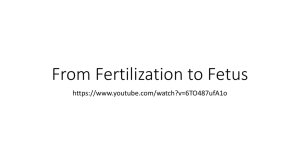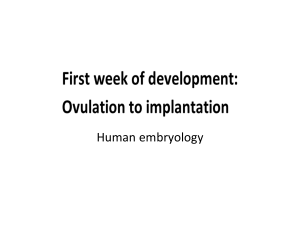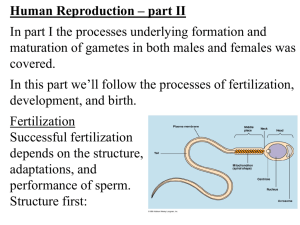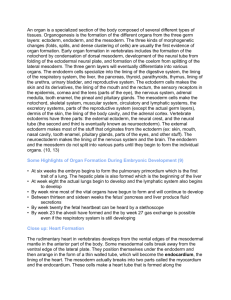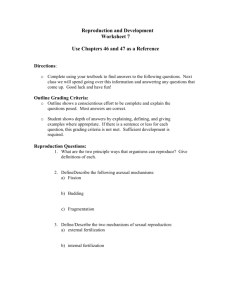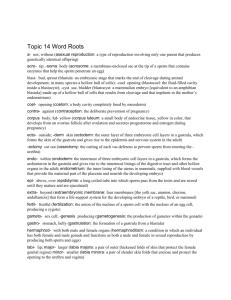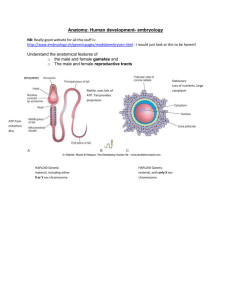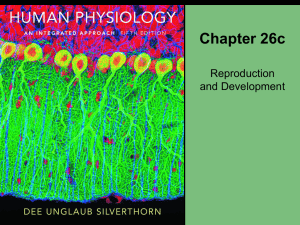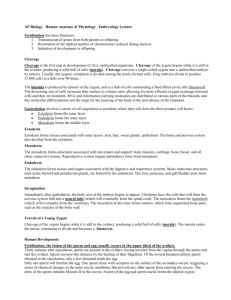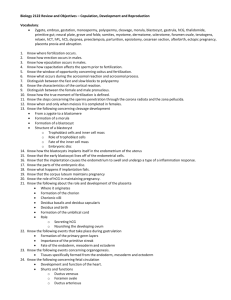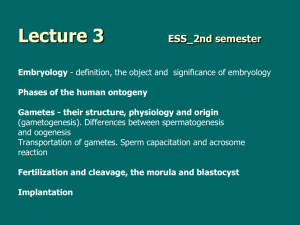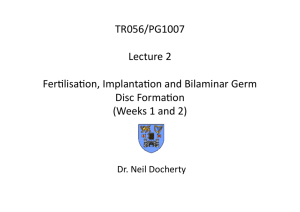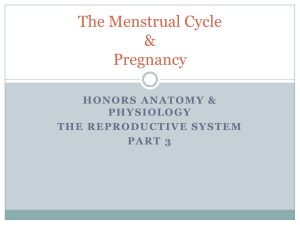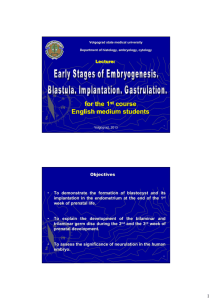Life'sGreatestMiracleWsheetw.answers
advertisement
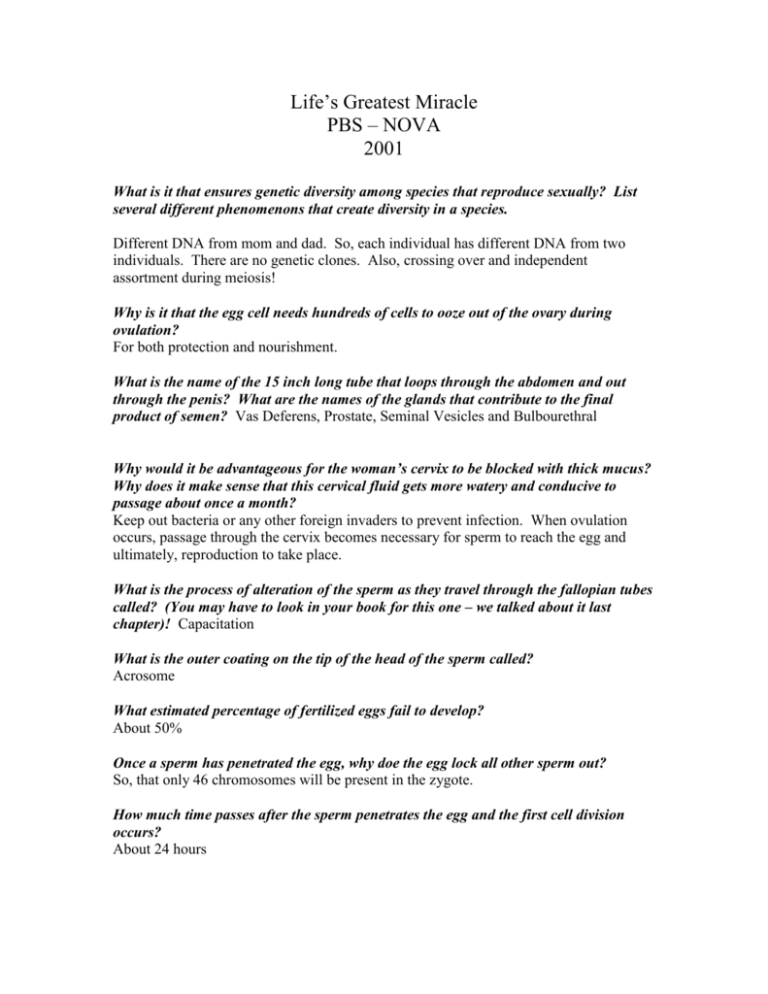
Life’s Greatest Miracle PBS – NOVA 2001 What is it that ensures genetic diversity among species that reproduce sexually? List several different phenomenons that create diversity in a species. Different DNA from mom and dad. So, each individual has different DNA from two individuals. There are no genetic clones. Also, crossing over and independent assortment during meiosis! Why is it that the egg cell needs hundreds of cells to ooze out of the ovary during ovulation? For both protection and nourishment. What is the name of the 15 inch long tube that loops through the abdomen and out through the penis? What are the names of the glands that contribute to the final product of semen? Vas Deferens, Prostate, Seminal Vesicles and Bulbourethral Why would it be advantageous for the woman’s cervix to be blocked with thick mucus? Why does it make sense that this cervical fluid gets more watery and conducive to passage about once a month? Keep out bacteria or any other foreign invaders to prevent infection. When ovulation occurs, passage through the cervix becomes necessary for sperm to reach the egg and ultimately, reproduction to take place. What is the process of alteration of the sperm as they travel through the fallopian tubes called? (You may have to look in your book for this one – we talked about it last chapter)! Capacitation What is the outer coating on the tip of the head of the sperm called? Acrosome What estimated percentage of fertilized eggs fail to develop? About 50% Once a sperm has penetrated the egg, why doe the egg lock all other sperm out? So, that only 46 chromosomes will be present in the zygote. How much time passes after the sperm penetrates the egg and the first cell division occurs? About 24 hours What is the blastocyst? What happens to the blastocyst that enables it to attach to the uterine lining? What could prevent the blastocyst from attaching to the uterine lining? What does the embryo do to counteract this potential danger? Hollow ball of cells that occurs after several early cell divisions (few hundred cells). About five days after fertilization, still in hard shelled zona. Sixth day, orchestrates escape. Blastocyst secretes an enzyme that eats through the zona. It escapes from the zona at which point it can attach to the uterine lining. Mother’s immune system sweeps in to potentially kill the foreign invader. Baby’s immune system secretes chemicals to suppress mom’s immune system (which is part of the reason that women will get sick early on). What is gastrulation? Use video and textbook if necessary. About two weeks after conception. It is when the blastocyst is about the size of a poppy seed. Blastocyst forms two bubbles that are separated by a thin sandwich of cells, which is a group of cells in the center of the two bubbles. At beginning of gastrulation, part of these cells in the center begin moving towards the center (inner cell mass), and then dividing in layers. Ectoderm, mesoderm and endoderm. What are the ectoderm, mesoderm and endoderm? Again, you will need to look in your textbook for help. Endoderm – becomes lungs, liver, digestive tract Mesoderm – becomes heart, muscles, bones and blood Ectoderm – becomes nervous system, skin and hair At what point is the primary neural tube already formed? Three weeks after fertilization. Less than 1/10th of an inch long. Primitive brain cells are exposed during this phase, but they are already trying to make connections between nervous cells. The hallmark of the early stages of development are cell division and cell differentiation! At what point does the heart begin to beat? Again, you may need to check your HBB notes or textbook. What is going on about 4 ½ weeks after fertilization? 4 ½ weeks after fertilization, 1/5 of an inch long. Primitive backbone there. Large brain developing. Eye developing as well. Why is it that different cells look differently and act differently, even though each cell has all the same DNA? Because different genes are turned on in different cells and those genes direct the production of different proteins. Different proteins give the cells different structures and different functions. Mention stem cells . . . and location. It seems that cells seem to know where they are because of chemical messengers. So, this is part of the reason that stem cells that are totipotent or pluripotent are so promising if and when they are injected in damaged tissue. Show the ultrasound pictures and see if they can pick some stuff out. SRY gene – explain why they say most of the time XX will be a girl and XY will most of the time be a boy, unless crossover gives the second X the SRY gene or strips the Y gene of the SRY gene. How long after fertilization is the embryo called a fetus? How big is the fetus at this point? How developed is the fetus? Two months, at this stage almost all organs are in place, though not working. Just over an inch long and 1/3 of an ounce. Where does the embryo get all of its resources for development? The placenta raids the mother’s blood for oxygen and nutrients. When does the eye begin responding to light? When does the ear actually work? For eyes, 5th or 6th month. Even though there by ninth week of development. Ear develops early as well, but needs bones for sound waves to work. So, after about five months of development, the bones are formed enough that the baby can hear. The sounds are distorted. What primarily happens in the last few months of development? Fat for insulation and long term energy stores. In brain, myelin, which is fatty deposits that help in nerve transmission, as learned in Lorenzo’s Oil. Primarily, baby grows, puts on weight – organs are fully formed, just get bigger. As the weeks progress, the babies need for fat exceed what the mother is able to provide, and therefore, the baby must come out or it will starve! Explain the three stages of labor. Again, you will need your textbook for this question. 1st stage – from the onset of cervical contractions, which is the beginning of labor, until the baby crowns (which is when woman is 10 cm dilated) 2nd state – when the woman pushes, from the time that woman is fully dilated (10 cm) until baby exits vaginal canal 3rd stage – delivery of placenta




